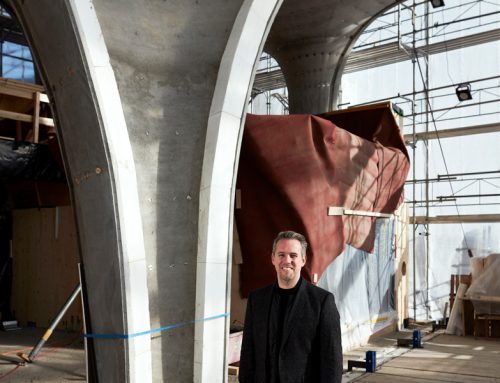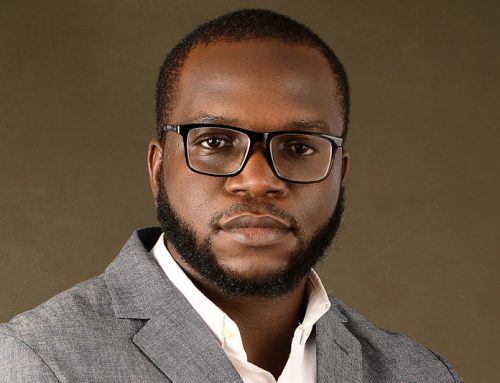Wits alumnus (BA 1984) Arthur Goldstuck, Head of World Wide Worx and Editor-in-chief of Gadget is a South African journalist, media analyst and commentator who talks to corporate audiences worldwide on technology trends that will shape the next decade.
A school of pink jellyfish just floated through my world or I floated through theirs while I was writing on my virtual desktop. After a while I felt like a diversion so I attended a virtual Cold Play concert but didn’t stay long because I don’t like crowds. Instead I explored the Wild Coast instead from a drone’s eye view, followed by a hike on Mars. Feeling a little weary, I went for a lie down. I think this was real, my pillow felt real but so did the dust on my boots from Mars.
This is what times spent with Arthur Goldstuck does to you. His is a world where reality, virtual reality (VR) and augmented reality (AR) are indivisible. From cyber currency to deep immersion VR to robotic waitrons, he is constantly exploring new technologies being conceived, developed or improved in order to create a roadmap of technology trends that will shape our lives.
What we can expect in 2017
“Let’s start with next year when VR and AR will go mainstream, and when VR will be the next major platform for social media, as Facebook boss Mark Zuckerberg has already told us,” Goldstuck explains.
In 2014 Facebook bought Oculus – a VR company makes VR headsets – for US$2billion – and together they are working on creating the social network VR experience.
VR, for those unacquainted with it, simulates physical presence in places in either the real world, or a computer-simulated reality or a hybrid of both, where the user interacts through an immersive multimedia experience.
AR, by comparison, is an overlay of content on the real world, such as a virtual desktop projected onto a desk, that you can work on or GPS data on your vehicle’s windscreen or Pokémon Go, the unprecedently popular free-to-play, location-based AR game. Another example is the table IKEA has developed for its concept kitchen that screens recipes on the tabletop based on the ingredients on the table.
Reality, virtual reality and imagination converge
VR and AR are increasingly converging, just as reality, virtual reality and imagination are increasingly converging. Goldstuck offers example of the Samsung Galaxy S7 launch in Barcelona earlier this year where journalists were invited to watch a virtual reality demo, using Samsung’s Gear VR headsets. When the time came to remove the headsets, there was the real life Zuckerberg, standing on the stage, ready to address them. The theme of his talk: that VR would be the next mainstream platform for social media.
The many incredible applications of this technology, including for education, is inspiring. Its inevitability is assured. Some mobile phone companies are giving away VR headsets with new phones purchased because they well know where technology is heading.
Goldstuck explains that the quality of the VR experience depends on the quality of the headset lenses, priced accordingly. You can currently buy the Google Cardboard VR headset online for less than R200, and assemble it yourself or you can pay anything from R400 to R10 000 for the high-end VR headsets.
Participate in VR experiences
“Big brands are having branded versions of Google Cardboard VR headsets made for them as a marketing exercise. Last year the New York Times gave away one million of them to its readers so that they could participate in VR experiences – from the Olympic Games to the war against ISIS – on the New York Times’ website,” says Goldstuck.
With the VR headsets you can currently experience and participate in virtual travel, 360-degree videos and movies, and games, all of which combine VR with AR. VR and AR headsets use tiny micro-electro-mechanical (MEMS) accelerometers and gyroscopes to keep track of the angle the headset is facing. When you move your head the software detects this and moves the scene you are viewing to correspond with your movement. This creates the feeling that you are actually in the scene.
Becoming Batman
“Some of the most common VR experiences currently available are rollercoaster rides, flying through space or a tour of a city or geographic area where you feel you are physically there, immersed in the environment and the experience,” explains Goldstuck whose favourite VR experience is Batman VR “where you find yourself looking into the bat cave through Bruce Wayne’s eyes. You put on the Bat suit and are immersed in being Batman.” Goldstuck experienced the demo version of Batman VR, which hasn’t yet been released.
Observer to participant
“There are many different VR resources that are already available, such as VR libraries that you can download, but the advance of this will be to experience that you are there – where you feel like a participant rather than an observer.” Here, the distinction between the virtual and the real world dissolves, to the extent, as Zuckerberg demonstrates, we will be able to make video calls between the virtual and real world. It’s just a matter of time before this app is released.
It’s also just a matter of months before we will be able to attend a real time sports event or music concert, and feel that we are at the game or concert, and in the crowd. We can already participate in recorded VR concerts – both Cold Play and U2 have done this – but we will soon participate in real time, through our VR headsets, no TV screen required.
What we can expect in 2020/21
“The technology underlying cyber currencies like Bitcoin is called blockchain, and is being explored by banks right now. It will go mainstream by 2020 but is already used as a transactional tool,” says Goldstuck.
Also in 2020, self-driving vehicles will become a common site on the road in many parts of the world. In late October 2016 a truck company called Otto collaborated with the Budweiser Beer company to make the first ever delivery of 51 744 cans of beer by a self-driving truck in Colorado. The truck was human controlled until it got onto the highway, and then the autopilot took over and drove 192kms (120 miles), equipped with gps, sensors and cameras.
“Whether this will happen in South Africa is questionable because our licensing regulations might not be able to accommodate it, but should it ever happen, it would greatly assist with common long haul problems such as driver fatigue,” says Goldstuck.
What we can expect in 2022/23
By 2022 we won’t be relying on a physical desktop or laptop. Instead, the keyboard will project onto any surface you want to work on, and the information will project onto a wall or any surface.
The Sony Xperia Projector, for example, which was also unveiled at Mobile World Congress in February 2016, projects a 21-inch display onto a table or wall, and picks up your hand and finger gestures within the display area, which makes the display interactive, so you don’t need a screen. This was followed by the launch in San Francisco in June this year of the Moto Z smartphone, paired with the Insta-Share Projector, which can project up to a 70-inch display – the equivalent of a large-screen TV.
“I foresee a time when we won’t need mobile phones at all,” explains Goldstuck. “We will have everything we need on a voice-activated wristband or ring, where you say ‘Turn on’ and the virtual laptop, movie or video call will display on the surface or environment of your choice. If you want to make a call, you’ll just say ‘phone Arthur’ and it will ask ‘which Arthur’ and give you a choice or you can type the number in virtually.”
What does this all mean for employment in the future?
Goldstuck says employment based on the technology of the future goes hand in hand with education:
“Most educators who research the philosophy and techniques of education accept that our current teaching format was designed to prepare students for the industrial age. Education has to change to meet the demands of the workplace of tomorrow, which is very far removed from the demands of the industrial age. The set of skills emerging as essential for the workplace of the future, and will be mainstream in many parts of the world include: problem solving, collaboration and creative thinking.
“I would like to add negotiation, and I am not just talking about political negotiation, I mean all forms of negotiation. It requires developing the skill to negotiate your position and persuade other people of the benefits of it because you cannot force your way on people in a world where everyone believes they have an equal voice.”
Stock trading algorithms
Goldstuck says jobs that don’t require these skills will repeatedly prove to be the jobs that can be replaced by automatons and artificial intelligence. One of these is stock trading. “This is already largely conducted by computer programmes with algorithms setting out what kind of trade must happen under which circumstances,” he explains.
Goldstuck believes this pattern will find itself repeating in numerous industries: “The jobs that will be safe are those that require creativity and high-level decision making, such as a choreographer who operates at such a high level of thinking and creativity that it is impossible to replicate at this stage.”
Jobs in the arts are safe for now
Overall, he says, jobs in the arts are safe for the time being, and jobs in the digital arts will flourish, hence qualifications such as Wits’ Digital Arts programme headed by Professor Christo Doherty is completely on track.
Journalism is safe where it requires creative and enterprising thinking to share and uncover stories. However, certain forms of financial reporting, such as reporting on company reports, is under threat and will be artificially executed in the next five to ten years.”
Architects, engineers and computer expertise will flourish
Other professions and trades he regards as safe are architecture and all forms of engineering – mechanical, software, electrical and computer engineering – which will be at the forefront of designing at all levels and building intelligence into systems and devices. All forms of computer expertise, including anti-hacking specialists, will continue to escalate. “The Wits initiatives by Professor Barry Dwolatsky at Tshimologong and the Johannesburg Centre for Software Engineering are closely aligned with this future,” he says.
Trades that will grow, include electricians and plumbers who are skilled for smart homes and offices, where everything from complex technology to renewable energy will require their input.
Drones, robots and amazing changes
Drones will become increasingly prominent – from goods delivery to surveying of everything from construction sites to water sources. Increasingly sophisticated robotics will also become mainstream.
“Robot waitrons in the Far East are already mainstream in the fast food industry, with 1000 robots produced every month in Japan for this industry,” Goldstuck continues. “You won’t find this kind of job replacement happening in South Africa because of our focus on human jobs, but globally it will be mainstream where robots will perform all sorts of functions, including assisting nurses with the care of the aged in developed countries with a rapidly ageing population.
“We’ll also see amazing developments in specialist skills such as robosurgery where a surgeon can be sitting anywhere in the world and operating on a patient thousands of kilometres away. This is already happening but it is not yet mainstream.”
There is so much more to say, but, in short, the world we know will be no longer in ten years time, with technology in the lead. There will be so many amazing changes and we need to fly with them, while at the same time looking after each other and our planet. Ten years from now, if we are still around, it will be wonderful to talk to Goldstuck again and see what has come to pass and what the future holds.
For more information:
http://thevirtual.space/video/
http://www.nytimes.com/marketing/nytvr/
http://vrlive.com/
http://www.sonymobile.com/us/products/smart-products/about/
http://www.gadget.co.za/moto-z-family-arrives-in-sa/





